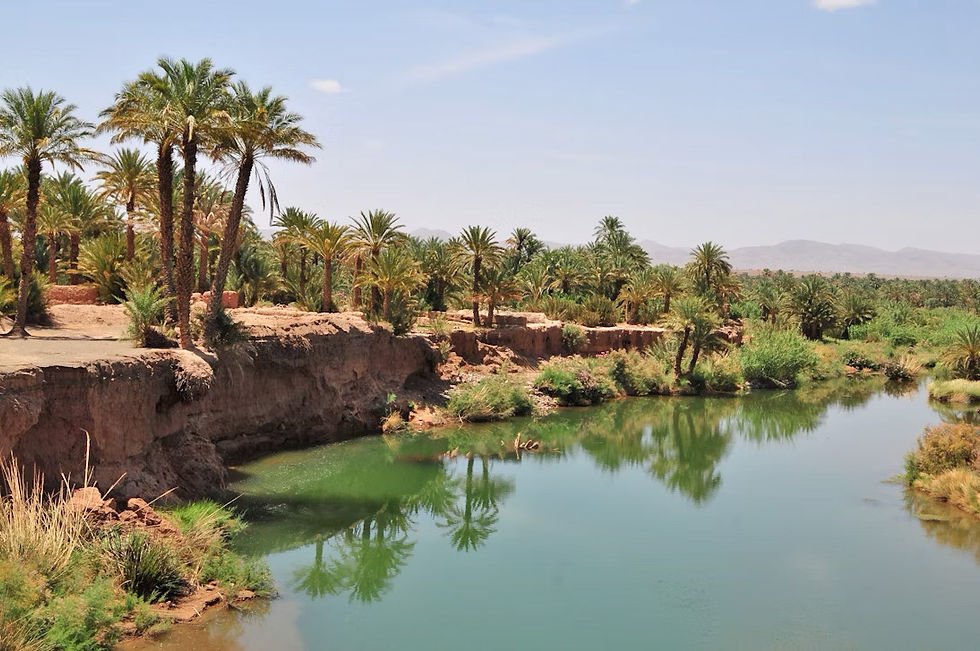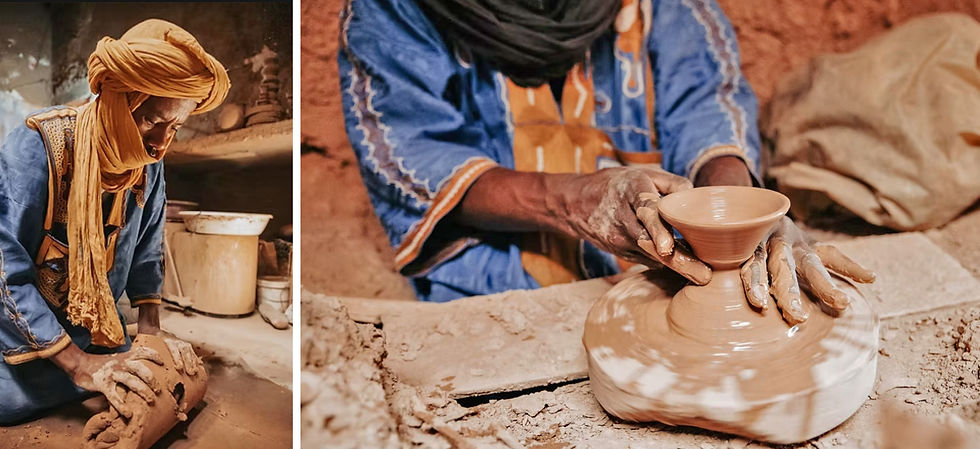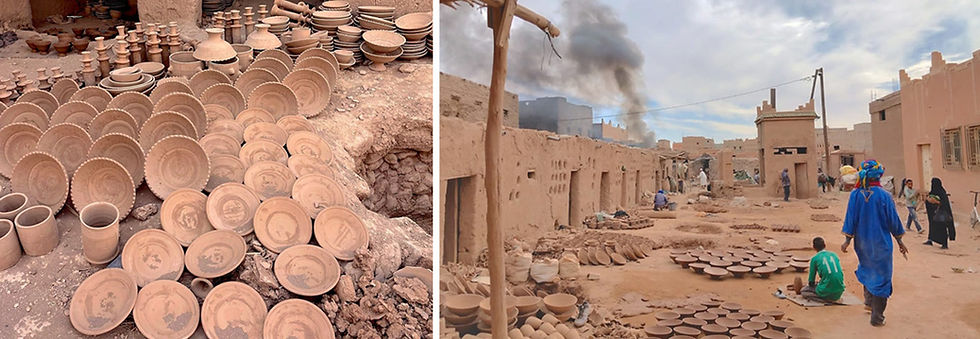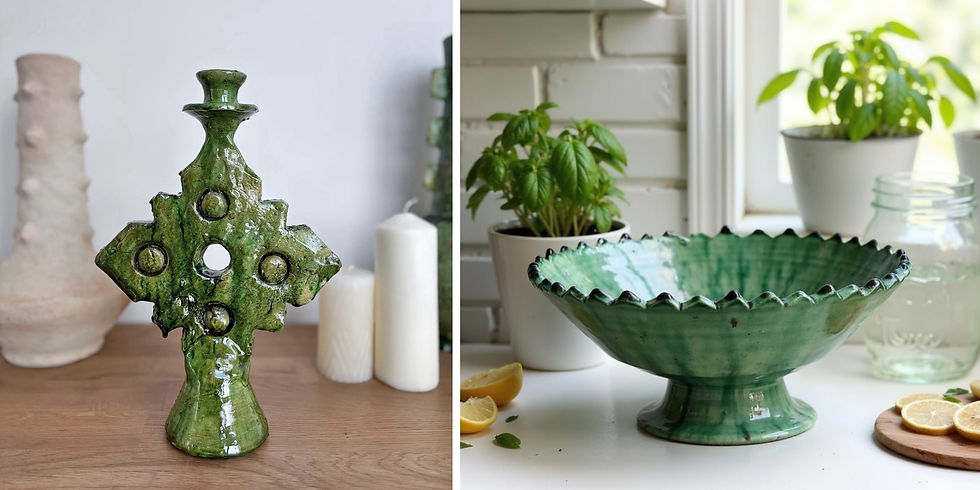Unveiled: Tamegroute’s Mesmerizing Desert Pottery Secrets
- Cake

- Aug 4
- 5 min read
Nestled in the heart of Morocco’s Draa River Valley, where the fertile palm groves give way to the endless dunes of the Sahara, lies Tamegroute. A village that feels like a whispered secret of the desert. Known as the "last place before the desert," Tamegroute is more than a geographical marker; it’s a living tapestry of history, spirituality, and artistry. For centuries, this remote oasis has been a crossroads of culture, trade, and creativity, most famously celebrated for its distinctive green pottery. This craft has captivated collectors, designers, and travelers worldwide. Let’s journey into Tamegroute’s story, uncover its historical treasures, and explore why its pottery is so special, important, and beloved.

Tamegroute: The Last Place Before the Desert
Tamegroute’s history dates back to the 11th century, when it emerged as a spiritual and intellectual center on the edge of the Sahara. It became the home of the Nasiriyya Sufi order, founded by Sidi Mohamed Ben Nacer. The village is known for its revered zaouia and one of Morocco’s oldest Quranic libraries, which holds over 4,000 manuscripts covering theology, astronomy, poetry, and more. These texts, some written on gazelle hide, reflect Tamegroute’s role as a beacon of knowledge along trans-Saharan trade routes. The village’s nickname, “the last place before the desert,” captures its liminal beauty, where the Draa River’s palm groves meet endless dunes.
This heritage of spirituality and resilience infuses Tamegroute’s pottery with profound meaning. The craft was seen as a form of spiritual practice—reflecting values like humility, patience, and devotion. Pottery workshops supported the religious community, and the distinctive green glaze carries symbolic meaning in Islam. More than just functional objects, these ceramics express a way of life shaped by faith and simplicity.
The Art of Tamegroute Pottery
Tamegroute’s green pottery is instantly recognizable, with its earthy, lustrous glazes ranging from deep emerald to pale olive, often flecked with imperfections that tell the story of its creation. This craft, dating back to the mid-17th century, was born when artisans from Fes, Morocco’s ceramic capital, brought their expertise to Tamegroute. Today, eleven families (originally seven) carry on this tradition, each guarding closely held techniques passed down through generations.

The Making of a Masterpiece The pottery’s journey begins with clay sourced from the depths of the Draa River, a material rich with the region’s geological history. Artisans shape this clay by hand on foot-powered wheels, a labor-intensive process that demands skill and patience. The true magic, however, lies in the glaze—a secret recipe blending copper, manganese, and barley flour.
This alchemy, applied before firing, creates the signature green hues that set Tamegroute pottery apart. Firing takes place in traditional kilns, often fueled by palm fronds or wood, where the interplay of heat, oxygen, and glaze produces unpredictable results.
No two pieces are identical; some emerge with glossy finishes, others with matte textures or subtle brown undertones. These variations—cracks, drips, and irregular edges—are not flaws but cherished hallmarks of the craft, reflecting the artisans’ mantra: "Perfection lies in imperfection." Journey back in time and discover more of Moroccan pottery's enchanting art. A Diverse Array of Forms Tamegroute pottery spans a wide range of forms, from functional to decorative. You’ll find bowls, plates, and tagines for everyday use, alongside vases, candlesticks, and abstract sculptures that elevate interiors with their rustic elegance. Recent innovations include modern designs like candleholders and tiles, blending tradition with contemporary appeal. Each piece carries the weight of Tamegroute’s heritage, making it a favorite among interior designers and collectors seeking authenticity.
Explore the benefits of timeless home decor and learn how to find your own style to create a home for lasting satisfaction.
Why It’s Special
What makes Tamegroute pottery special is its deep connection to place and process. The green glaze evokes the lush palm groves of the Draa Valley, a vibrant contrast to the arid Sahara. The handcrafted nature ensures each piece is a singular work of art, imbued with the artisan’s touch and the unpredictable beauty of the kiln. This uniqueness resonates with those who value slow, intentional craftsmanship in an era of mass production. The pottery’s cultural significance is equally profound. It embodies Tamegroute’s resilience as a desert outpost, where creativity thrives despite harsh conditions. For the artisans, pottery is not just a livelihood but a spiritual act, rooted in the village’s Sufi traditions of mindfulness and community.

The Importance and Popularity of Tamegroute Pottery Tamegroute pottery holds a cherished place in Moroccan culture and beyond. Locally, it supports the livelihoods of artisan families and preserves a craft that has defined the village for centuries. The cooperative system, where families work together to produce and sell pottery, ensures that profits benefit the community, sustaining traditions and fostering economic resilience. Globally, Tamegroute pottery has surged in popularity, particularly among those drawn to bohemian, artisanal aesthetics. Its earthy tones and organic forms complement a range of decor styles, from minimalist Scandinavian to eclectic Mediterranean. High-profile retailers like Anthropologie and Etsy shops have introduced Tamegroute ceramics to international markets, while design blogs praise their "timeless yet trendy" appeal. Travelers visiting Morocco often seek out Tamegroute’s potters’ quarter, where they can witness the craft in action and purchase pieces directly from artisans.
The pottery’s rise in popularity also stems from its story. In a world increasingly disconnected from handmade traditions, Tamegroute ceramics offer a tangible link to history and humanity. Collectors value not just the objects but the narratives they carry—stories of desert resilience, Sufi spirituality, and artisanal dedication.

Trivia and Tales from Tamegroute
Legend has it that the green glaze was discovered by accident when a potter mixed local minerals with barley flour, creating a vibrant hue that mirrored the oasis. This "miracle" glaze became Tamegroute’s signature, though the exact recipe remains a closely guarded secret.
Tamegroute’s Quranic library is one of Morocco’s hidden gems, with manuscripts illuminated with gold. Scholars still visit to study these texts, making the village a beacon of knowledge in the desert.
In the 20th century, Tamegroute’s pottery tradition nearly faded as younger generations sought urban opportunities. The revival of tourism and global interest in artisanal goods has helped sustain the craft, with cooperatives empowering artisans to preserve their heritage.
Tamegroute pottery has adorned Moroccan palaces, with some pieces reportedly commissioned for royal households in the 18th century, cementing its status as a cultural treasure.

A Legacy Worth Celebrating Tamegroute is more than a village; it’s a testament to human creativity and resilience at the edge of the Sahara. Its green pottery, with its luminous hues and storied imperfections, captures the spirit of a place where history, spirituality, and art converge. Whether you’re drawn to its cultural significance, its aesthetic allure, or the stories woven into each piece, Tamegroute pottery invites you to hold a piece of the desert’s heart in your hands. Check out our handbook for ethical traveling.
Supporting Tamegroute’s Legacy
To engage with Tamegroute pottery, visit the village’s potters’ quarter, a 10-hour drive from Marrakech or a detour from Zagora, where open-air workshops reveal the craft’s living heritage. Buy authentic pieces from cooperatives or ethical retailers like Travel Tamegroute, Côté Bougie, Akoja, or Joanna Ceramic, ensuring artisans are fairly compensated. Look for the green glaze and handcrafted imperfections, and avoid mass-produced imitations that lack the soul of the originals.
By understanding and sharing Tamegroute’s story, you’re not just collecting pottery—you’re preserving a legacy that has thrived against the odds for centuries. You can find our own handmade beldi cups from Morocco, here on our webshop.

Cake is a lifestyle brand offering unique homewares and accessories that celebrate culture and individuality. Founder Laurine Brugman designs products that withstand trends and fads - creating timeless pieces that you’ll treasure forever. We’re passionate about preserving traditional crafts and passing on a little bit of love with our hand-made items. All of our items are produced in limited runs to eliminate waste and ensure quality.




Comments